SAAB 9-3 2003 User Guide
Manufacturer: SAAB, Model Year: 2003, Model line: 9-3, Model: SAAB 9-3 2003Pages: 256, PDF Size: 21.66 MB
Page 11 of 256
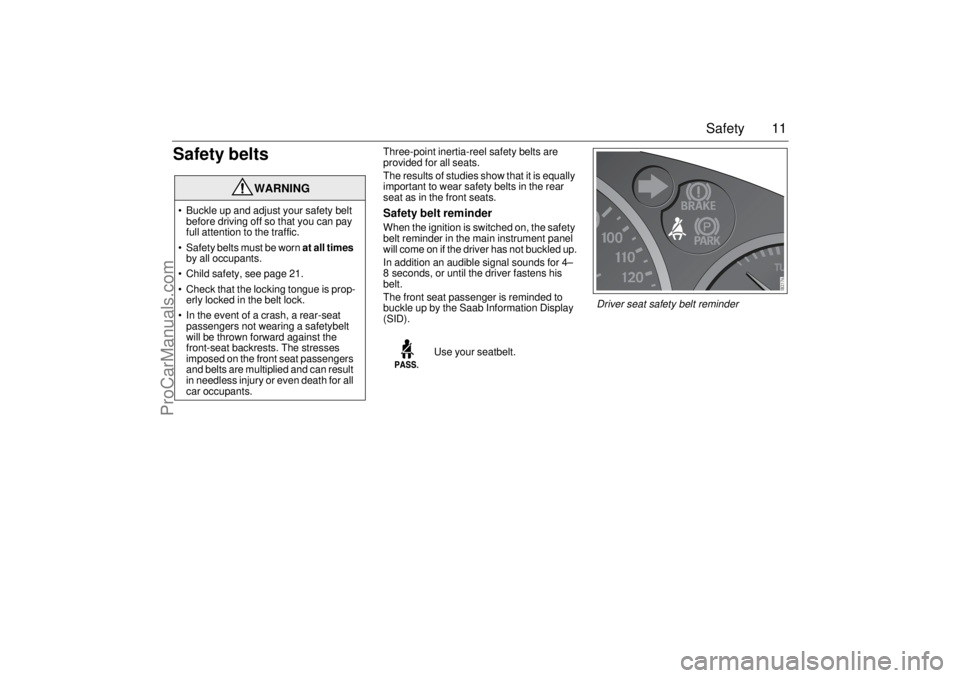
11 Safety
Safety belts
Three-point inertia-reel safety belts are
provided for all seats.
The results of studies show that it is equally
important to wear safety belts in the rear
seat as in the front seats.Safety belt reminderWhen the ignition is switched on, the safety
belt reminder in the main instrument panel
will come on if the driver has not buckled up.
In addition an audible signal sounds for 4–
8 seconds, or until the driver fastens his
belt.
The front seat passenger is reminded to
buckle up by the Saab Information Display
(SID).
WARNING
Buckle up and adjust your safety belt
before driving off so that you can pay
full attention to the traffic.
Safety belts must be worn at all times
by all occupants.
Child safety, see page 21.
Check that the locking tongue is prop-
erly locked in the belt lock.
In the event of a crash, a rear-seat
passengers not wearing a safetybelt
will be thrown forward against the
front-seat backrests. The stresses
imposed on the front seat passengers
and belts are multiplied and can result
in needless injury or even death for all
car occupants.
Use your seatbelt.
Driver seat safety belt reminder
ProCarManuals.com
Page 12 of 256
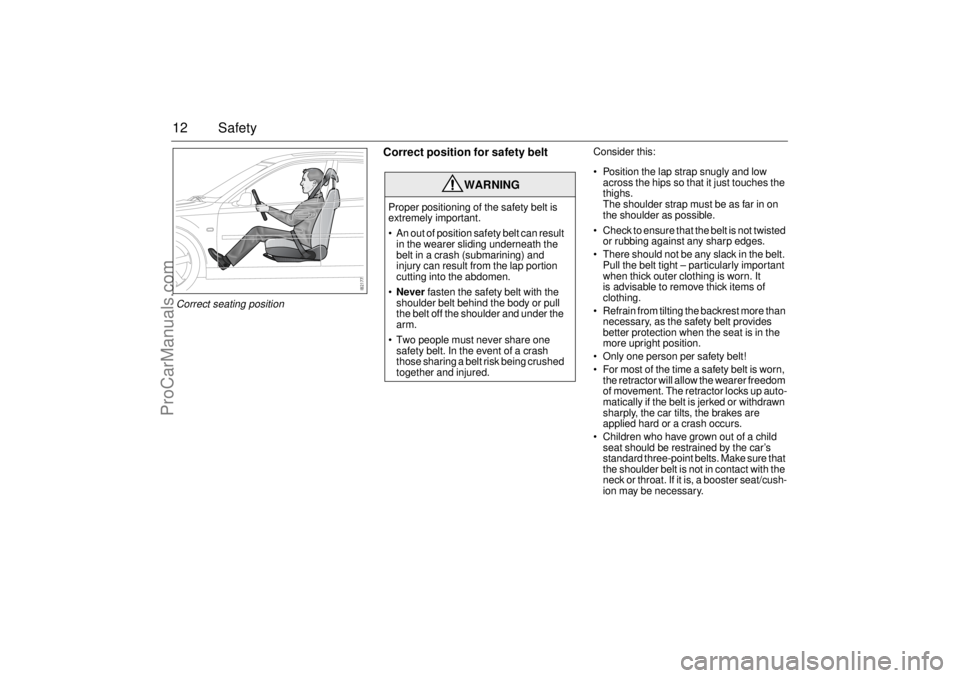
12 Safety
Correct position for safety belt
Consider this:
Position the lap strap snugly and low
across the hips so that it just touches the
thighs.
The shoulder strap must be as far in on
the shoulder as possible.
Check to ensure that the belt is not twisted
or rubbing against any sharp edges.
There should not be any slack in the belt.
Pull the belt tight – particularly important
when thick outer clothing is worn. It
is advisable to remove thick items of
clothing.
Refrain from tilting the backrest more than
necessary, as the safety belt provides
better protection when the seat is in the
more upright position.
Only one person per safety belt!
For most of the time a safety belt is worn,
the retractor will allow the wearer freedom
of movement. The retractor locks up auto-
matically if the belt is jerked or withdrawn
sharply, the car tilts, the brakes are
applied hard or a crash occurs.
Children who have grown out of a child
seat should be restrained by the car’s
standard three-point belts. Make sure that
the shoulder belt is not in contact with the
neck or throat. If it is, a booster seat/cush-
ion may be necessary.
WARNING
Proper positioning of the safety belt is
extremely important.
An out of position safety belt can result
in the wearer sliding underneath the
belt in a crash (submarining) and
injury can result from the lap portion
cutting into the abdomen.
Never fasten the safety belt with the
shoulder belt behind the body or pull
the belt off the shoulder and under the
arm.
Two people must never share one
safety belt. In the event of a crash
those sharing a belt risk being crushed
together and injured.
Correct seating position
ProCarManuals.com
Page 13 of 256
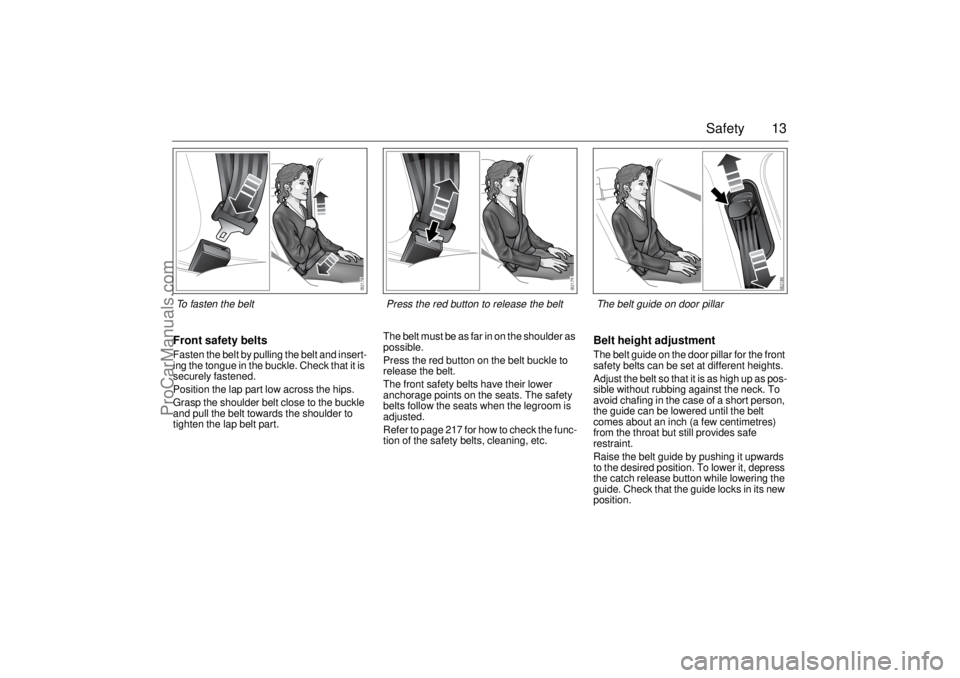
13 Safety
Front safety beltsFasten the belt by pulling the belt and insert-
ing the tongue in the buckle. Check that it is
securely fastened.
Position the lap part low across the hips.
Grasp the shoulder belt close to the buckle
and pull the belt towards the shoulder to
tighten the lap belt part.The belt must be as far in on the shoulder as
possible.
Press the red button on the belt buckle to
release the belt.
The front safety belts have their lower
anchorage points on the seats. The safety
belts follow the seats when the legroom is
adjusted.
Refer to page 217 for how to check the func-
tion of the safety belts, cleaning, etc.
Belt height adjustmentThe belt guide on the door pillar for the front
safety belts can be set at different heights.
Adjust the belt so that it is as high up as pos-
sible without rubbing against the neck. To
avoid chafing in the case of a short person,
the guide can be lowered until the belt
comes about an inch (a few centimetres)
from the throat but still provides safe
restraint.
Raise the belt guide by pushing it upwards
to the desired position. To lower it, depress
the catch release button while lowering the
guide. Check that the guide locks in its new
position.
To fasten the belt Press the red button to release the belt
The belt guide on door pillar
ProCarManuals.com
Page 14 of 256
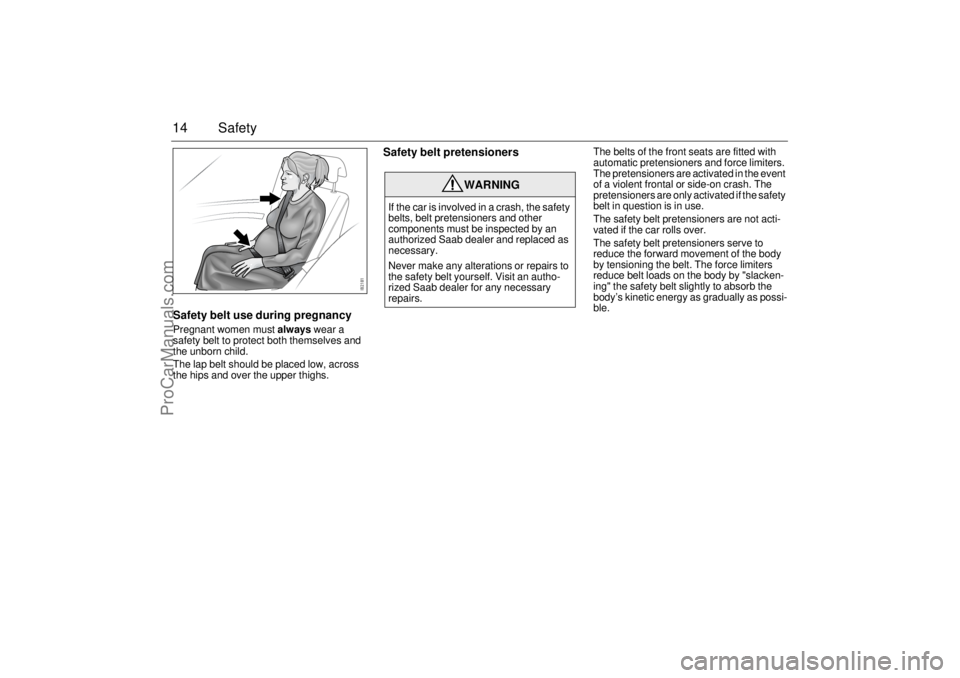
14 SafetySafety belt use during pregnancyPregnant women must always wear a
safety belt to protect both themselves and
the unborn child.
The lap belt should be placed low, across
the hips and over the upper thighs.
Safety belt pretensioners
The belts of the front seats are fitted with
automatic pretensioners and force limiters.
The pretensioners are activated in the event
of a violent frontal or side-on crash. The
pretensioners are only activated if the safety
belt in question is in use.
The safety belt pretensioners are not acti-
vated if the car rolls over.
The safety belt pretensioners serve to
reduce the forward movement of the body
by tensioning the belt. The force limiters
reduce belt loads on the body by "slacken-
ing" the safety belt slightly to absorb the
body’s kinetic energy as gradually as possi-
ble.
WARNING
If the car is involved in a crash, the safety
belts, belt pretensioners and other
components must be inspected by an
authorized Saab dealer and replaced as
necessary.
Never make any alterations or repairs to
the safety belt yourself. Visit an autho-
rized Saab dealer for any necessary
repairs.
ProCarManuals.com
Page 15 of 256
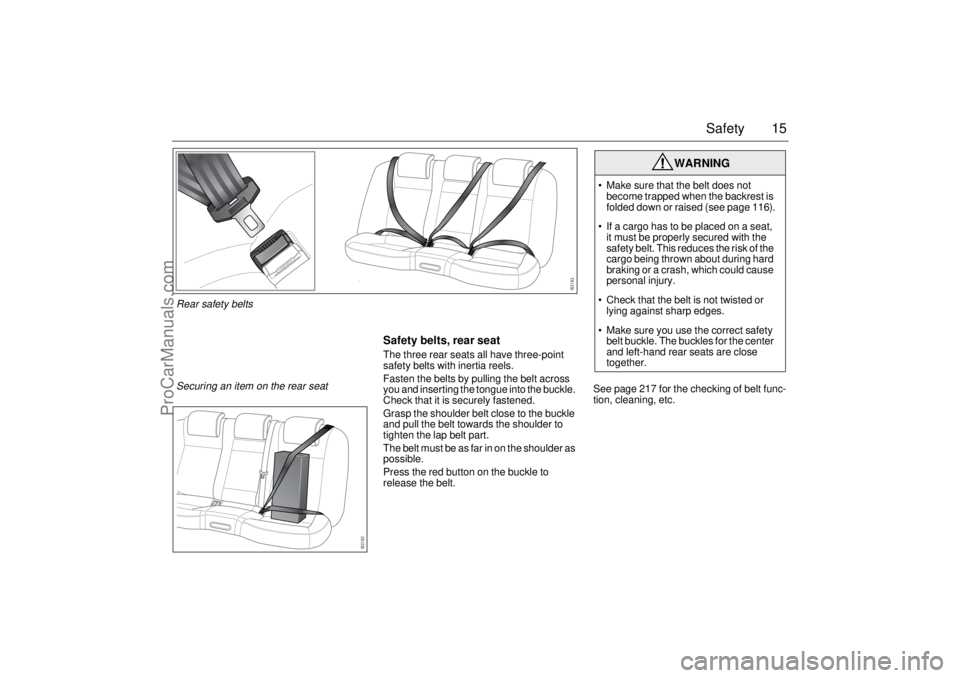
15 Safety
Safety belts, rear seatThe three rear seats all have three-point
safety belts with inertia reels.
Fasten the belts by pulling the belt across
you and inserting the tongue into the buckle.
Check that it is securely fastened.
Grasp the shoulder belt close to the buckle
and pull the belt towards the shoulder to
tighten the lap belt part.
The belt must be as far in on the shoulder as
possible.
Press the red button on the buckle to
release the belt.See page 217 for the checking of belt func-
tion, cleaning, etc.
WARNING
Make sure that the belt does not
become trapped when the backrest is
folded down or raised (see page 116).
If a cargo has to be placed on a seat,
it must be properly secured with the
safety belt. This reduces the risk of the
cargo being thrown about during hard
braking or a crash, which could cause
personal injury.
Check that the belt is not twisted or
lying against sharp edges.
Make sure you use the correct safety
belt buckle. The buckles for the center
and left-hand rear seats are close
together.
Rear safety belts
Securing an item on the rear seat
ProCarManuals.com
Page 16 of 256
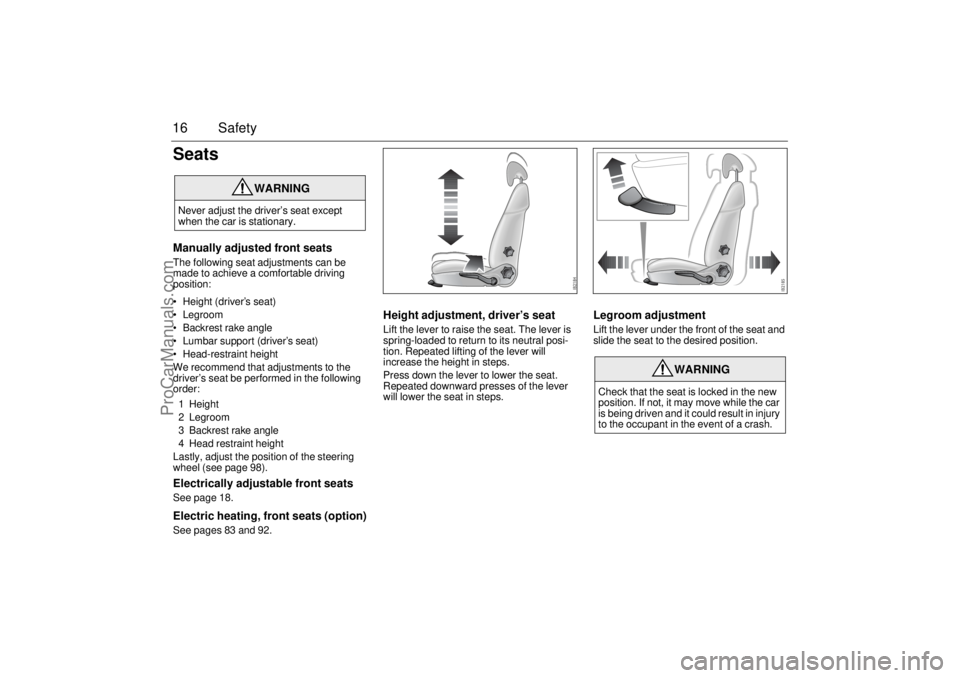
16 SafetySeatsManually adjusted front seatsThe following seat adjustments can be
made to achieve a comfortable driving
position:
Height (driver’s seat)
Legroom
Backrest rake angle
Lumbar support (driver’s seat)
Head-restraint height
We recommend that adjustments to the
driver’s seat be performed in the following
order:
1 Height
2 Legroom
3 Backrest rake angle
4 Head restraint height
Lastly, adjust the position of the steering
wheel (see page 98).Electrically adjustable front seatsSee page 18.Electric heating, front seats (option)See pages 83 and 92.
Height adjustment, driver’s seatLift the lever to raise the seat. The lever is
spring-loaded to return to its neutral posi-
tion. Repeated lifting of the lever will
increase the height in steps.
Press down the lever to lower the seat.
Repeated downward presses of the lever
will lower the seat in steps.
Legroom adjustmentLift the lever under the front of the seat and
slide the seat to the desired position.
WARNING
Never adjust the driver’s seat except
when the car is stationary.
WARNING
Check that the seat is locked in the new
position. If not, it may move while the car
is being driven and it could result in injury
to the occupant in the event of a crash.
ProCarManuals.com
Page 17 of 256
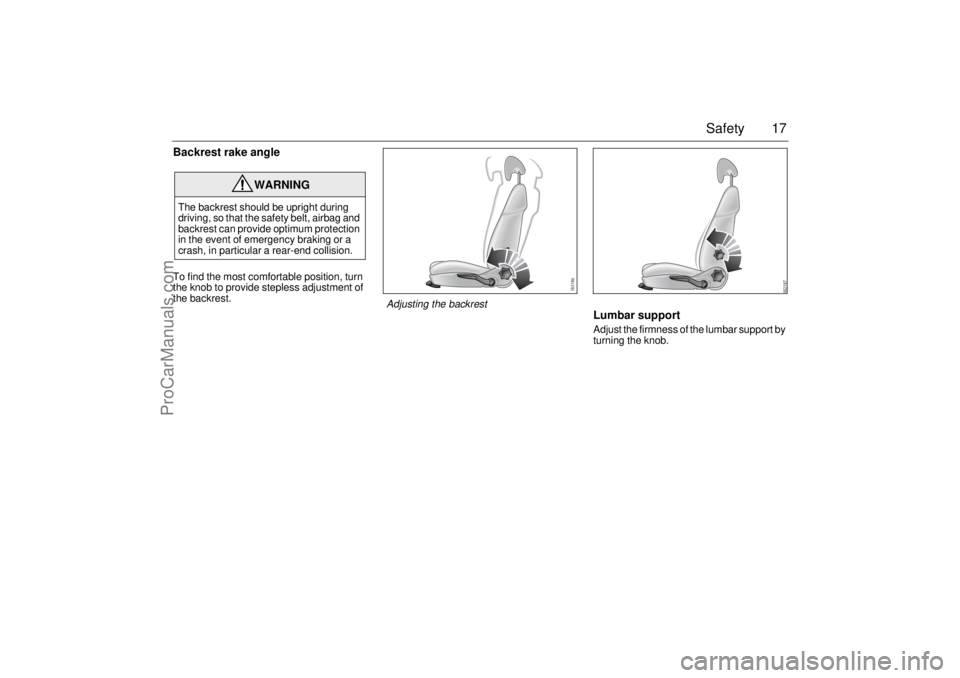
17 Safety
Backrest rake angleTo find the most comfortable position, turn
the knob to provide stepless adjustment of
the backrest.
Lumbar supportAdjust the firmness of the lumbar support by
turning the knob.
WARNING
The backrest should be upright during
driving, so that the safety belt, airbag and
backrest can provide optimum protection
in the event of emergency braking or a
crash, in particular a rear-end collision.
Adjusting the backrest
ProCarManuals.com
Page 18 of 256

18 SafetyElectrically adjustable front seats
(option)With the doors closed the seats can only be
adjusted when the ignition is ON.
However, there are two exceptions:
To facilitate getting into the car, both seats
can be adjusted when either of the front
doors is open.
The seats can be adjusted up to
20 seconds after both doors have been
closed (applicable only to cars without
window and sunroof pinch protection).
Height adjustment and seat angleAdjust the height of the seat with the rear
section of the front lever.
Adjust the angle of the seat with the front
section of the front lever.
Legroom adjustmentAdjust the legroom with the front lever.
WARNING
The seats are actuated by powerful
motors. Bear this in mind when adjust-
ing the seat, and make sure that noth-
ing gets caught and damaged. Ensure
that nothing can be trapped behind the
seat when adjusting it.
Bear in mind that children can be
injured if they play with the electrically-
operated seats.
Always remove the remote control
when you leave the car to prevent
personal injury caused by the electri-
cally adjustable seats, for example,
due to children playing.
ProCarManuals.com
Page 19 of 256
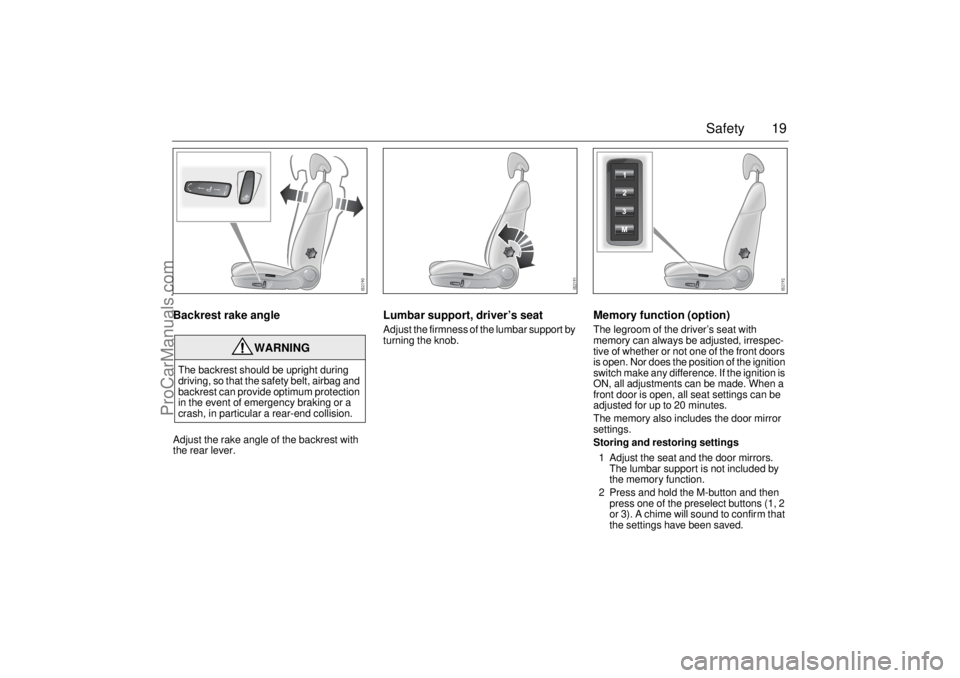
19 Safety
Backrest rake angleAdjust the rake angle of the backrest with
the rear lever.
Lumbar support, driver’s seatAdjust the firmness of the lumbar support by
turning the knob.
Memory function (option)The legroom of the driver’s seat with
memory can always be adjusted, irrespec-
tive of whether or not one of the front doors
is open. Nor does the position of the ignition
switch make any difference. If the ignition is
ON, all adjustments can be made. When a
front door is open, all seat settings can be
adjusted for up to 20 minutes.
The memory also includes the door mirror
settings.
Storing and restoring settings
1 Adjust the seat and the door mirrors.
The lumbar support is not included by
the memory function.
2 Press and hold the M-button and then
press one of the preselect buttons (1, 2
or 3). A chime will sound to confirm that
the settings have been saved.
WARNING
The backrest should be upright during
driving, so that the safety belt, airbag and
backrest can provide optimum protection
in the event of emergency braking or a
crash, in particular a rear-end collision.
ProCarManuals.com
Page 20 of 256
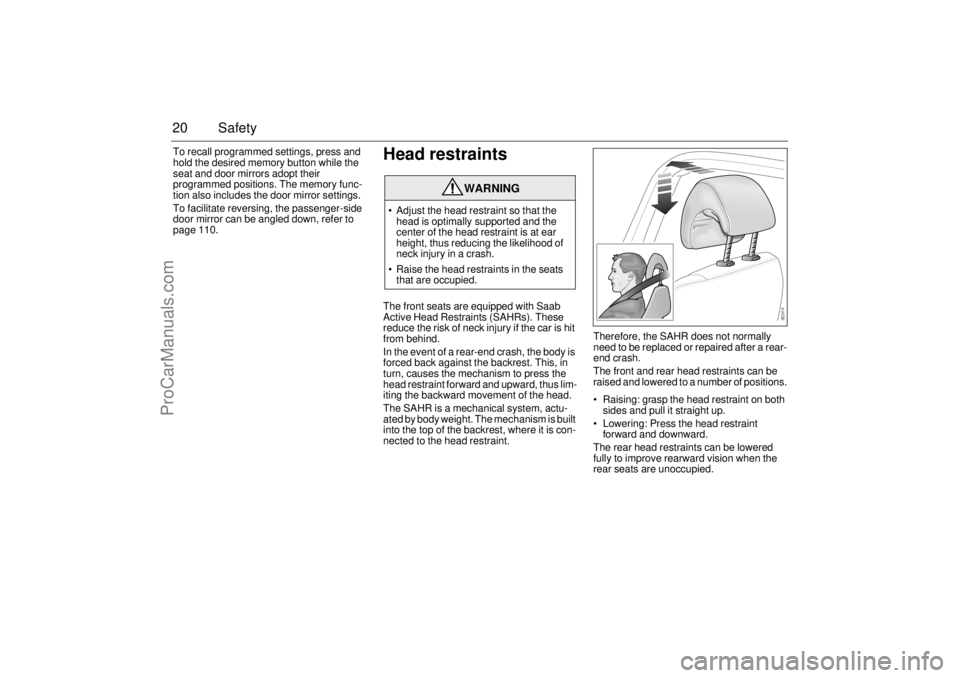
20 SafetyTo recall programmed settings, press and
hold the desired memory button while the
seat and door mirrors adopt their
programmed positions. The memory func-
tion also includes the door mirror settings.
To facilitate reversing, the passenger-side
door mirror can be angled down, refer to
page 110.
Head restraintsThe front seats are equipped with Saab
Active Head Restraints (SAHRs). These
reduce the risk of neck injury if the car is hit
from behind.
In the event of a rear-end crash, the body is
forced back against the backrest. This, in
turn, causes the mechanism to press the
head restraint forward and upward, thus lim-
iting the backward movement of the head.
The SAHR is a mechanical system, actu-
ated by body weight. The mechanism is built
into the top of the backrest, where it is con-
nected to the head restraint.Therefore, the SAHR does not normally
need to be replaced or repaired after a rear-
end crash.
The front and rear head restraints can be
raised and lowered to a number of positions.
Raising: grasp the head restraint on both
sides and pull it straight up.
Lowering: Press the head restraint
forward and downward.
The rear head restraints can be lowered
fully to improve rearward vision when the
rear seats are unoccupied.
WARNING
Adjust the head restraint so that the
head is optimally supported and the
center of the head restraint is at ear
height, thus reducing the likelihood of
neck injury in a crash.
Raise the head restraints in the seats
that are occupied.
ProCarManuals.com